 Image search results - "ise" Image search results - "ise" |

On June 16, 2007, Imazu marked the 90th anniversary of the song by organizing a boat cruise on Lake Biwa and other events. Omi-Imazu Station had a sign directing guests to Imazu Port. 90周年の記念「琵琶湖周航クルーズ」の近江今津駅内
|
|

Imazu Port. A large crowd of people waiting to board the chartered boat for a 3-hour cruise on Lake Biwa to commemorate the 90th anniversary of the song, Biwako Shuko no Uta.
|
|

The "Rio Grande" cruise boat awaits at Imazu Port on a miraculously sunny day during the rainy season. 梅雨でありながら、奇跡的にこんないい天気になった。今津港
|
|

Reception desk for passengers. A little over 100 people joined the cruise. クルーズの受付
|
|

Boarding time at Imazu Port. In the forefront is a song monument for Biwako Shuko no Uta.
|
|

Megan and Jamie Thompson about to board the boat. トンプソン姉妹
|
|

Boat name "Rio Grande" operated by Biwako Kisen. Named after Shiga's sister state in Brazil. There is also the "Michigan" paddlewheel boat named after Shiga's sister state in the USA.
|
|

Inside the front of the Rio Grande boat. 琵琶湖周航クルージング
|
|

Open deck at the rear. The boat departed at about 11:30 am.
|
|

We passed by various scenic spots such as Shirahige Shrine, noted for the torii gate in the lake.
|
|

Meoto-Iwa Wedded Rocks off the coast of Futami-cho, Ise city, Mie Prefecture. 夫婦岩
|
|

Shirahige Shrine 白髭神社
|
|

The Wedded Rocks are part of Futami Okitama Shrine known for frog sculptures. 二見興玉神社
|
|

Misty Horikiri Port in Omi-Hachiman. Boats leave here for Okishima island, Lake Biwa's largest island.
|
|
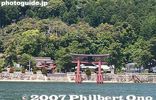
Shirahige Shrine torii as seen from the cruise boat.
|
|

The shrine is dedicated to Sarutahiko and Ukano-mitama. Sarutahiko is a god which serves as a pathfinder guide. Deities for land/sea transportation safety. 二見�
|
|

Omi-Maiko with green pines on white sands. 近江舞子の「松は緑に 砂白き」
|
|

The frog is Sarutahiko's messenger. Frog is called "kaeru" in Japanese, which is a homonym for the another word meaning "return home." If you travel a lot, pray here for a safe return. 夫婦岩
|
|

Boat for Okinoshima at Horikiri Port
|
|

Omi-Maiko appears in the song.
|
|
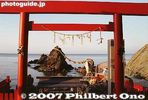
Futami Okitama Shrine does not have a main hall (Honden) like most other shrines. It worships the Okitama Sacred Stone in the ocean beyond the Wedded Rocks. 二見興玉神社
|
|

Rolling with the waves
|
|

Lantern and sunset at Futami Okitama Shrine
|
|
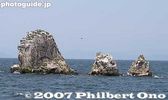
Okino-shiraishi Rocks, a favorite resting place for birds which turned the rocks white from bird droppings. Four rocks stand 80 meters deep in the lake. Out of the water, the tallest stands 14 meters high. 沖の白石
|
|

Sunset at Futami Okitama Shrine. In the old days when traveling was a hazardous undertaking in Japan, pilgrims who traveled to worship at the Ise Grand Shrines prayed here for a safe return home.
|
|

So what does "Coral shrine" mean in the song? (There's no coral in the lake.) "I think it just refers to a beautiful place..." 「珊瑚の宮」はどういう意味?
|
|

The shimenawa rope bonding the Wedded Rocks is replaced three times a year. May 5, when these photos were taken, is one of the days when they replace the rope. First, they gathered at the shrine at 10 am for a 30-min. prayer ceremony.
|
|

We landed on Chikubushima for about an hour. Jamie and Megan also sang in English in front of the Verse 4 song monument.
|
|
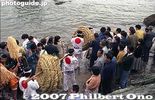
Men carry spanking-new shimenawa ropes to the rocks.
|
|

Jamie and Megan Thompson sing in English in front of the Verse 4 song monument, Chikubushima. Next time we need to have an amplifier.
|
|
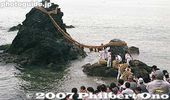
The Wedded Rocks are actually a type of torii gate for worshipping the Okitama Sacred Stone in the ocean.
|
|

Jamie and Megan Thompson sing in English in front of the Verse 4 song monument, Chikubushima. They sang up to Verse 4. ジェイミーとメゲン・トンプソン姉妹が歌う
|
|

The torii on the larger rock is quite small. The sacred rope is replaced three times a year on May 5, September 5, and at the end of December.
|
|

The man holds the 90th Anniversary tour sign as a guide for the tour guests.
|
|

5月5日、9月5日と12月下旬には夫婦岩の大注連縄の張り替え神事が行われる。これらの写真は5月5日に撮影された。
|
|

Getting back on the boat. Little over a hundred people came on this cruise. If people knew it was gonna be such a beautiful day during this rainy season, more would have certainly come.
|
|
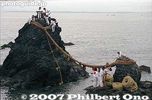
The men begin to cut off the old rope. Those sharp sickles soon made short work of the old sacred ropes which were brought ashore in small pieces.
|
|

Entering Okinoshima Port. Okishima is the largest island in Lake Biwa. MAP
|
|

Sachiko Tsuji, the MC, interviews the sisters before they sang on the boat. 自動販売機前でインタービュー。船内の客は姉妹の顔や姿がほとんど見えへん。
|
|

The ceremony attracts a large crowd.
|
|

Jamie and Megan Thompson sing in English while cruising on Lake Biwa. 船の真ん中で歌って自動販売機がバックになって最悪。客に背中を向くばかりで申し訳ない。船の一番前に歌いたいと頼んだけど...
|
|

The shimenawa rope actually consists of five smaller ropes. They cut the ropes one by one.
|
|

Side of boat
|
|

After they sang, there was a mad rush to buy the CD priced at 800 yen. 英語版CDの購入者が殺到。
|
|

The ropes are now completely cut, breaking the bond between the two rocks.
|
|

Then they signed autographs on the CD. CDのサインを求める。
|
|
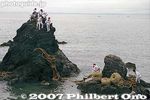
The old rope is taken away.
|
|

More autographs. 姉妹はやはり人気者。
|
|
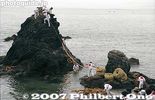
The new ropes are strung across the two rocks. A small rope tied to the end of the large rope is used to pull the large rope up the rock.
|
|

Okishima Port
|
|
|
|

Water lilies. The melody of the song originally came from a song called "Hitsuji-gusa" which means water lilies.
|
|

The first rope is wound around both rocks.
|
|

Water lily (Hitsuji-gusa). ひつじぐさ
|
|

The second rope is installed.
|
|

After the boat cruise, there was a walking tour of Imazu. A special exhibition was held at the local community center in Imazu. 「周航の物語展」今津東コミセン
|
|
|

「周航の物語展」今津東コミセン
|
|

One by one, the men carefully positioned the new sacred ropes on the two Rocks. All the while, young children and young men are chanting on the shore.
|
|

This showcase showed things from the old Daisan Koto Gakko college.
|
|
|

Student uniform for Daisan Koto Gakko school.
|
|
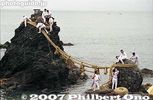
Replacing the rope for the Wedded Rocks, Mie Pref.
|
|

Daisan Koto Gakko Rowing club towel
|
|

Five ropes are being positioned and made taut.
|
|

Daisan Koto Gakko book of songs
|
|
|

Chojiya ryokan along the lake shore. Likely this is where Oguchi Taro and crew stayed. 丁子屋という旅館
|
|

All the while, the cheering section chants and wave streamers.
|
|

Inside Chojiya. Very impressive Japanese-style inn with lake views.
|
|
|

Room in Chojiya ryokan.
|
|
|

Inside Chojiya. The inn is famous for serving duck.
|
|
|

Another local landmark was this former bank building designed by William Merrell Vories who designed many buildings in Shiga, especially in Omi-Hachiman.
|
|

Pieces of the old rope. Anyone could take home the pieces of old sacred rope if they wanted.
|
|

Leaving Okinoshima (we'll be back).
|
|

Inside former bank building.
|
|

Making sure that the rope is aligned and positioned correctly.
|
|

In the evening during 5 pm-6:30pm, a slide show lecture about Oguchi Taro and Yoshida Chiaki was given by Iida Tadayoshi, a song researcher. Held at a hotel in Imazu. 歌と映像でつづる「小口太郎と吉田千秋の物語」講演会
|
|

The job is finished.
|
|

German-made accordian used by Yoshida Chiaki was also on display.
|
|

The rope installers return to shore.
|
|

View of Imazu shore from hotel
|
|
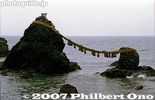
Wedded Rocks with a new rope. Japan has numerous other Wedded Rocks and stones, but this is by far the most famous.
|
|

A reception was held afterward in the hotel. The mayor of Takashima, Hidekazu Kaito, speaks. I gave him a copy of our CD. 高島市長 海東英和
|
|

Interestingly, the mayor's first name "Hidekazu" means "English-Japanese." The next day, at the choir contest, he told us that he listened to and liked our song.
|
|

Kanpai!
|
|

Meeting Iida Tadayoshi, song researcher and former NHK announcer.
|
|

In the end, we all sang the song, including the mayor of Takashima.
|
|

最後に皆で周航歌を歌う。
|
|
|

Setagawa River boat cruise modeled after the Ichiban-Maru paddlewheel steamboat which cruised on Lake Biwa in the 19th century. In operation during warmer months from Ishiyama-dera port and stopping at Nango Aqua Biwa and Seta-no-karahashi ports.
|
|

Ariake Coliseum (Colosseum) in Koto Ward, Tokyo, near Odaiba. One of Tokyo Apache's home courts in Tokyo. Easily accessible via Yurikamome Line (Ariake Station) and Rinkai Line (Kokusai Tenjijo Station). 有明コロシアム
|
|

Entrance to Ariake Colosseum for the game between Tokyo Apache and Toyama Grouses on Dec. 27, 2008.
|
|

Sign for Tokyo Apache vs. Toyama Grouses on Dec. 27, 2008.
|
|

Division standings as of Dec. 21, 2008. Tokyo Apache in 1st place, and Grouses in last place among the six teams in the Eastern conference of the bj-league.
|
|

Uniform replica for sale.
|
|

T-shirts for sale.
|
|

Towels
|
|

Join the Tokyo Apache booster club.
|
|
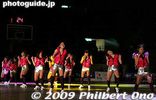
Pregame entertainment by the Tokyo Apache Dance Team (equivalent to cheerleaders). Unfortunately, pro basketball is still a minor sport in Japan. Few people klnow about the bj-league and the teams. Many people in Tokyo have never heard of Tokyo Apache.
|
|

It's a shame because it's quite entertaining to watch bj-league basketball games. They are geared for entertainment before and during the game.
|
|

Ticket prices are also inexpensive. Perhaps they should offer 500 yen tickets on special campaign days so more people will come out to watch.
|
|

The basketball players also service the fans with autographs and handshakes before and after the game.
|
|

Tokyo Apache team members are introduced as they go through a gauntlet of cheerleaders.
|
|

Ariake can get quiote cold in winter though. They might turn on the heater or they might not.
|
|
|
|
|

The Tokyo Apache Dance Team girls swirl around as the player passes through.
|
|

Some practice shots.
|
|
|

Tip off
|
|

John "Helicopter" Humphrey
|
|
|
|

Masashi Joho
|
|
|
|
|

Tokyo Apache Dance Team do their stuff during time outs. They are the cheerleaders who appear on Saturday games.
|
|
|
|
|
|
|

Half-time show by Tokyo Apache Dance Team.
|
|

Darin Maki
|
|
|
|
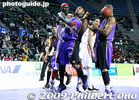
A foul by Babacar Camara led to a brief scuffle between him and John Humphrey. After some deliberation by the referees, both were expelled from the game.
|
|

Jun Iwasa
|
|
|
|
|
|
|

Cohey Aoki
|
|

Cohey
|
|
|
|
|
|

Sponsors
|
|

Tokyo Apache Dance Team use a large towel as a prop.
|
|
|
|
|
|

Progression of a dunk shot.
|
|
|
|

Head coach Joe Bryant speaks to the crowd at the end of the game.
|
|

Sign for Tokyo Apache vs. Toyama Grouses on Dec. 28, 2008 at Ariake Colosseum.
|
|

Fans entering Ariake Colosseum for the game between Tokyo Apache and Toyama Grouses on Dec. 28, 2008.
|
|

Fans entering Ariake Colosseum for the game between Tokyo Apache and Toyama Grouses on Dec. 28, 2008.
|
|

Autographed basketball.
|
|

Signing autographs before the game.
|
|
|

Masashi Joho signs autographs.
|
|
|

Cheering section
|
|

Kids basketball game
|
|

A free throw game is one pregame activity.
|
|
|
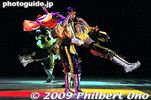
Pregame entertainment by Gum Q, a terrific dance troupe of kids who act as the team cheerleaders.
|
|
|
|
|
|

Practice shots
|
|
|
|
|

Tip off
|
|
|
|
|
|
|
|
|
|
|
|

Going up against Babacar Camara.
|
|

Gum Q
|
|
|
|
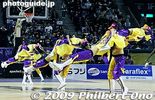
Wow, GumQ were great performers.
|
|
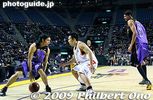
Some footwork by Masashi Joho.
|
|
|

Nick Davis
|
|

Sponsors
|
|
|
|
|
|
|
|
|

Skills Challenge was held during halftime. Several contestants try to dribble through a course for shooting and passing a basketball.
|
|

Tokyo Apache team bench.
|
|

GumQ kids are very well trained.
|
|
|
|
|

Full of pep and vitality. Great for basketball games.
|
|
|
|
|
|
|
|
|
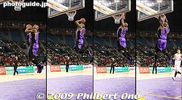
Dunk shot by John Humphrey.
|
|

Dunk shot progression.
|
|
|

Babacar Camara again as John's nemesis.
|
|

Coach Bryant advises John.
|
|
|
|

Cohey for a free throw.
|
|

Team huddle
|
|

Joho for a free throw.
|
|

A sweet victory by the Tokyo Apache following a defeat the day before.
|
|
|
|
|

Joe Bryant
|
|
|
|
|
|
|

Toyama Grouses head coach Takatoshi Ishibashi, a former player for the Grouses.
|
|

Tokyo Apache head coach Joe Bryant (Kobe's dad) is upbeat after his win as he talks to the press through an interpreter.
|
|
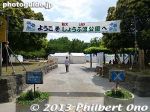
Shobu-numa Koen Park has five patches of irises that bloom in early June. About 140 varieties of irises and over 8,000 irises bloom. Very impressive for a neighborhood park. Near Kita-Ayase Station on the Chiyoda Line subway.
|
|
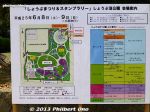
Map of the park. The iris patches are colored purple.
|
|
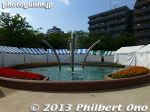
They also hold an iris festival on the early weekend in June. I visited before the weekend festival.
|
|
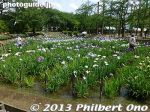
The first patch of irises.
|
|

I went before the weekend so it's not so crowded.
|
|
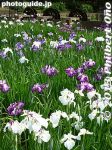
The park and irises turned out to be very nice. There are also shaded benches to sit and enjoy the flowers. A nice break from my computer screen.
|
|
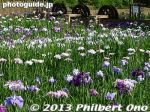
Waterwheels and irises.
|
|
|
|
|
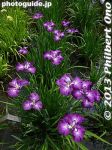
Irises at Shobu-numa Park in Adachi, Tokyo.
|
|
|
|
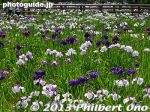
Irises at Shobu-numa Park in Adachi, Tokyo.
|
|
|
|
|
|
|
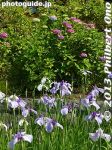
The irises are accented by some hydrangea at Shobu-numa Park, Adachi, Tokyo.
|
|
|
|
|
|
|
|
|
|
|
|
|
|
| 1209 files on 5 page(s) |
1 |
 |
 |
|